As the COVID-19 pandemic spread across the U.S. last spring, decisions to close schools in many places came relatively quick. Decisions about child care, however, were another matter. Astute governors recognized that, although we didn’t know much about the impact of the virus on children, essential workers still needed child care – and not just first responders and health care providers, but millions of low-wage workers who are foundational to the functioning of our economy. In Illinois, as in most states, child care programs remained open, even in diminished capacity.
Though programs continued serving children and families across the country, there was significant concern about what impact this health crisis would have on the child care industry and its long-term viability. The sector was already struggling with undervalued and undercompensated staff and slim, complicated budgets often built on a mix of insufficient public funding and private payments from families.
There was also concern for the health and well-being of early childhood caregivers. Although child care providers’ orientation to health and sanitation has shown to help reduce transmission of the virus within child care settings, exploding community spread is challenging decisions to keep programs open. Further, the majority of those who care for children in child care programs are Black and Latinx women who find themselves and their communities at greatest risk for both contracting COVID-19 and experiencing poor outcomes due to the systemic racism that underscores health disparities in our country.
Early in the pandemic, key portions of Illinois’ early childhood system were stabilized with safeguarded funding for services, whether they continued in-person or virtually. Providers serving children in the state’s Child Care Assistance Program were afforded enrollment-based payments, and later modified attendance-based payments. Stipends and rate add-ons were also available to those deemed as “Emergency Child Care.”
While these steps were critical, it was clear that more work needed to be done to reach child care programs who had less of their budget covered by these public funding streams, or who serve smaller percentages of children in Child Care Assistance Program.
Fortunately, Congress acted quickly in the spring to pass federal COVID-19 relief packages, including the CARES Act. In Illinois, Governor J.B. Pritzker worked with the Illinois General Assembly to direct CARES Act dollars to help businesses cope with the loss of revenue they were experiencing and support small businesses through the pandemic so that they could return post-pandemic.
Notably, Governor Pritzker dedicated 50% (i.e., $270 million) of those business interruption funds to a specific program for child care providers, Child Care Restoration Grants (CCRG), to fill the gap between their usual levels of revenue and the resulting impact of reduced enrollment and attendance in classrooms. The program, which kicked off in September, permitted eligibility for all licensed child care programs, both home- and center-based and regardless of source of revenue.
Unfortunately, though, CCRG ended on November 30, with no future federal funding available to continue. Since the programs first grants, more than $250 million has been distributed to nearly 6,000 child care providers in 95 of Illinois’ 102 counties – the majority of which are home-based providers in areas outside of the larger metropolitan Chicago area and its collar counties. Providers who received the grants were more likely to report that private pay from families makes up around 40-50% of their revenue, with Child Care Assistance Program funds making up most of the balance. A much smaller percentage of providers received other state or federal revenue. Fortunately, only a very small number of programs were found to be ineligible for the CCRG funds.
The CCRG program proved to be critical for allowing child care programs to remain open, especially those with less access to public funding. While the state should leave no stone unturned to find a way to continue these grants, the reality of a COVID-19-impacted state budget and the failure of the Fair Tax proposal in the recent election, state dollars are scarce or worst, nonexistent.
To make child care supports available and reliable for the duration of this tragic public health emergency, the federal government must step in. Multiple COVID-19 relief bills drafted this fall have demonstrated that child care funding is a key priority for some. In addition, public polling continues to show that Americans understand–whether due to their own personal challenges or common sense–that strengthening our child care sector is a critical element of economic recovery. However, the longer Congress waits, the more child care programs will close. While some closures are temporary, others are permanent. This number will only increase as this crisis continues without an urgent response from Congress.
Child care programs not only provide safe and enriching settings for children, but also fundamentally allow parents to work and be successful employees, while knowing their children are being well-cared for. Programs also serve as employers and economic drivers – they are small, community businesses that purchase food, supplies and transportation services necessary for carrying out their function and mission.
A fundamental question remains for us. Will we act now to secure the economic health of the child care sector? Or, like our initial response to the COVID-19 pandemic, will we wait until the problem is so bad that recovery becomes near impossible?
Once we can gain control of the pandemic and begin to return to normalcy, the economic health of our country will depend on the availability of child care for parents to physically return to their jobs. This is true whether you are a middle-income American currently juggling work and caring for your children at home right now, or whether you’re a low-wage worker, who saw your job evaporate during the pandemic.
A robust COVID-19 stimulus package is desperately needed by the American people on many fronts. Congress should make this its top priority – and ensure the passage of a package that directs significant funds to child care programs across our country and invests in young children and their families.

